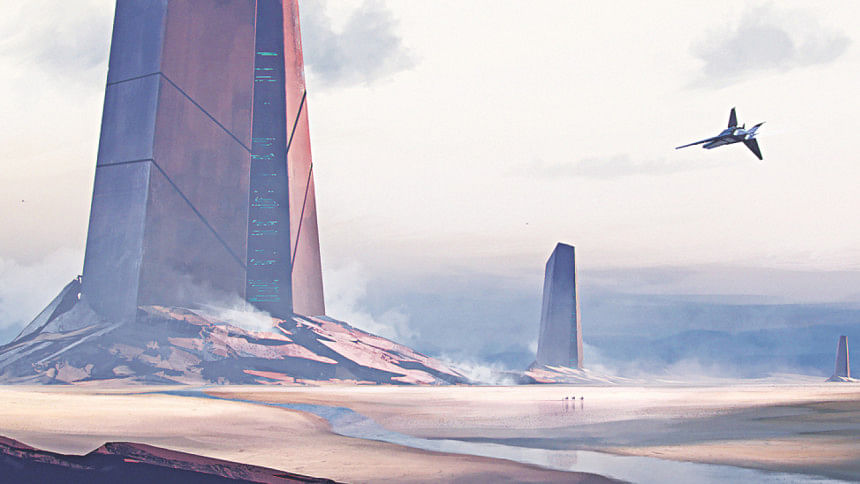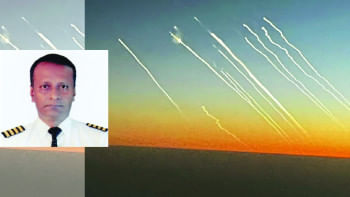The towers smell like rain

For all intents and purposes, the world ended 600 kilometres ago.
The Sky Country exists outside civilisation, boundless and as inhospitable as its namesake. Folk-tales from the garden-states along the terminus populate this desert with legendary monsters and sad ghosts in an attempt to bandage the bleak terror of its emptiness.
It is a common enough thing for people who live in the mountains to abandon their unwanted there. Even respectable families from the states will on occasion drive up one of the passes and tunnels in the mountains to leave:
The issue of unhappy pregnancies
Parents too old to be cared for with economy
Corpses of interest to lawmen
Still, those who are of a mind to think of such things surmise that once travel to and from the desert was common. The kilometre-wide artery called Lopa Gate was not drilled through a mountain to aid infanticide or to commune with ghosts. It lies in stately decay, the path blocked with debris and shanty-towns near its southward mouth. Great lights once lined its length but these and the circuitry—and indeed everything else—have been ripped away by centuries of people with more pressing concerns than historical preservation.
Nevertheless, Lopa Gate gleams—its surfaces coated with some sheen impervious to neglect and vandalism, reflecting the slum-dwellers’ cookfires and tacky brothel and temple lighting. Should you choose to fly through it your vehicle lights will produce a respectable bloom. If you drive through it, tunnel-dwellers will cannibalise you and your car for scraps and parts. The citizen courts of the garden-states do not rule there. The Desert Cult’s commandments are unknown. Under the dark weight of the mountain, the Lopa people worship murky gods and obey only the oldest law of hunger.
One wonders what the tunnel looked like in its heyday, when the lights were on.
If you look for them, you will find a few people who have travelled into the Sky Country and lived to tell the tale. Many are mystics and philosophers who sought the punishing solitude out of ascetic masochism. There are survival junkies who try to make it on their own as long as possible. It would also be popular with young lovers looking for an undisturbed rendezvous—but braving the tunnel-dwellers and the mountain bandits requires a truly ardent libido.
One-off journeys, no commuters. Still, for all things there is an exception.
Travel east along the mountains until you arrive at the place. It is a poor launch-pad, a simple hub such as you will find on trade routes long dry. Perching between the peaks a ship lies under a heavy tarp, and on those rare nights when all the moons are visible there is activity around it.
Happy figures arrive in their ones and twos from distant homesteads downhill to greet the maintenance crew at the waystation. Good brew is drunk. It is a reunion. As they carouse, they prepare a few empty cargo crates for the morning’s flight.
The tarp comes off with the rising light. The ship is surprising—not the weathered trawler one might expect but a gleaming cutter with fire that flows blue from the engines. This is for speed.
Two crates are lifted onto a side compartment that already contains collapsible shears and hampers. The ground crew give it a quick wipe but the effort is redundant. Lots are drawn for the privilege of flying the cutter and two of the visitors win. Hugs are exchanged before they board.
The trickiest part is navigating the peaks and ravines at high speed but past that there is but the sky and the sand. The horizon is laced with the faded blue of nameless mountains.
The towers rise out of the earth 600 kilometres from Lopa Gate.
They are vast, tall enough to be mountains in their own right and steam escapes from the vents at their bases. They are smooth-surfaced and faintly glowing. One may recognise the luminescence from the tunnel coating at Lopa Gate. The towers would be blinding bright and almost invisible from a distance on a regular day but now the clouds are up and the sun is cloaked.
The pilots take the cutter into the dark slit of the closest tower. The parting rises and narrows just a few kilometres below the structure’s top. There is weather in this shelter, condensation escaping from the ground and the building’s interior, percolating upwards to the roof and falling gradually below.
Green lights delineate the various levels and docking bays and one is chosen at random. The welcome mechanisms are automated and not a soul stirs within the structure’s bulk. We disembark into a necropolis.
The resting dead line the halls and concourses in chilled compartments behind sheer glass. There are millions here, physically preserved by systems that draw strength from the earth’s heat for many subterranean miles. The place hums with the air treatment system’s work and old Earth music playing in surround sound.
The cutter’s crew make their way past the corpses with their hampers and shears. Despite the circumstances, the tone of the tower’s interior is not of creeping dread but of a soft regret. The storytellers to the south would have been discomfited. Some of the deceased are certainly inhuman but the respect with which they have been laid out belie their monstrous forms. The only ghosts stalking the corridors are the dead singers on the PA system:
By the time your sun is rising there
Out here it’s turning blue
The silver rockets coming
And the cherry trees…*
There is nothing external to blatantly identify the spot where the pilots pause, though clearly, long practice has taught them what to look for. The body within the compartment that holds their attention is that of a young woman of plain aspect. She has been placed with flowers in her hair and these are dry but well-preserved. Of greater interest are the flowers that sprout out of her eyes and slightly ajar mouth. Blooming vines spread out from underneath the silken funerary shroud.
The flowers are a brilliant yellow.
With care one of the pilots slides the glass aside. Refrigeration gas escapes, but more is constantly pumped into the chamber so it is only a momentary loss. With shears, a few of the flowers are snipped from her face and ears. The shroud over her body is undisturbed.
For the rest of the day, they fan throughout the tower collecting flowers from the departed. Some are yellow, others are blue. Pink is rarest and most beautiful. None of the variants can be found in the world. The garden-states would pay fortunes to study them: reason enough for the secret of them to be closely kept.
Hampers full, the pilots return to the cutter to place the flowers in the crate, repeating until sunset. Many of the flowers were already beginning to die in their chambers as the pilots tarried too long. No matter: they would bloom again after the next allmoonrise. Life and death moving in rhythm through the mausoleums in the desert.
The moon is bright over the Sky Country when the cutter flies home. The pilots are quiet, though they have taken a care to record the songs playing in the tower turning distant behind them. These they listen to on the return flight.
The temperature keeps falling
Soon there will be no lights
Just a red glow and a glass coffin
Watched by someone through the night.
Far from the world, the towers glow white.
*Blur, Pyongyang
The writer is an artist and an MA candidate in International Migration at the University of Kent. Read more of this sort of thing in Disconnect: Collected Short Fiction.

 For all latest news, follow The Daily Star's Google News channel.
For all latest news, follow The Daily Star's Google News channel. 



Comments